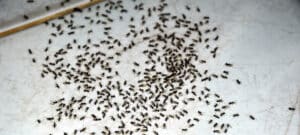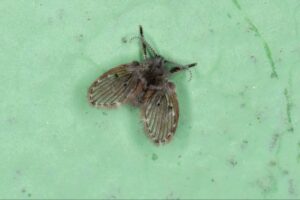Home / Blog / Rodents / What’s Scratching Inside Your Walls? Discover How to Get Rid of Mice in Walls.
What’s Scratching Inside Your Walls? Discover How to Get Rid of Mice in Walls.

Scientifically reviewed by Daniel Baldwin, BCE, CCFS, CP-FS
-Published on May 3, 2023
-Updated on July 21, 2023
Mice enter homes by squeezing through openings as small as a nickel or dime. A tiny crack or gap in a house’s foundation, wall, ceiling, or floor gives mice easy entry to find shelter, food, and a warm place for breeding. Once you have rodents in the walls of your home, their numbers can multiply. Learn how to recognize if you have a mouse problem, the damage they can cause, and how to get rid of mice in walls.
What attracts mice to your home?
Food and shelter are the main attractants for mice. When outdoor temperatures drop, mice are drawn to the warmth and food inside our homes. Mice aren’t picky about their food—they’ll eat any bits of uncovered or unpackaged foods in kitchens and pantries, leftover crumbs, insects, and anything else they can find. They’ll also chew up insulation, cardboard boxes, and paper for nesting materials.
Other attractants for mice are piles of clutter around garages, basements, or attics they can use for hiding and creating nests.
If you have tall grasses, bushes, or weeds close to your foundation, mice make hide there and naturally find their way into your home for warmth. It’s a good idea to keep the landscaping near your foundation and exterior walls free from debris.
Signs of mice in walls
Look for these tell-tale signs of mice living in your walls or elsewhere in the home. Knowing what to look for helps you identify where mice are nesting. The more signs of mice you notice, the more likely it is that you’re dealing with an infestation that needs professional intervention.
- Sounds: The sound of mice in walls can become loud, especially when the house is quiet in the morning and at night. Mice in walls sometimes sound like larger animals are inside your home because the noises are amplified when many rodents are scurrying around together. If you hear noises like skittering or rustling, rap on the wall. The sounds often stop for a few moments and begin again when there’s silence.
- Droppings: Mice leave droppings behind wherever they travel as they forage for food or water. Mouse droppings look like tiny black pellets with pointed ends.
- Holes: Mice chew out small round holes and tunnels to travel through so they can get to food sources and other nests they’ve built near warm appliances or attics. Holes chewed in cereal boxes or cookie boxes are another sign of mice.
- Food debris: Finding crumbs and debris near your kitchen closets or close to where mice are nesting is a sign that these creatures are getting into your human or pet food sources.
- Shredded materials: In addition to tearing through insulation in walls, mice also shred fabrics, paper, and other materials to create nests. Look for shredded items in areas that aren’t often used to help determine if mice are present.
- Odors: House mice give off a musky scent from the urine they leave behind as they travel through your home. If the infestation is large, the odor will have a stale ammonia smell coming from hidden areas, and the odor won’t go away until the mice are gone.
- Tracks: Mice running around the house may leave tracks or runways you can detect with a flashlight. The tracks are made up of smudges, urine stains, feces, or footprints. If mice are actively infesting your house, put down a thin layer of powder or flour on those areas so you can confirm the trails they make more easily.
Where there is one mouse, there will typically be many more to come as mice reproduce rapidly. The common house mouse, Mus musculus, is 5-7” long (including the tail) and weighs just half an ounce. A mouse’s life span is a year or less, but within that year, one female mouse can deliver up to 60 baby mice, each of which can reproduce within 10 weeks of being born.
What kind of damage can mice cause in the walls?
Mice can cause a lot of damage to a home, so it’s important to deal with them immediately.
Some common damage that can occur includes:
- Electrical wiring: Mice like to chew on electrical wires because most wiring has a soy-based coating that rodents are attracted to. This can cause electrical shorts and potential fire hazards.
- Insulation: Mice use insulation to make their nests. They also tunnel through it when working their way through the walls and ceilings of your home.
- Wood: Mice will chew on the wood of a home causing structural damage. Mice teeth never stop growing so they are constantly gnawing and chewing on whatever they can find.
- Holes: Mice may create holes in walls, ceilings, flooring, etc. to gain entry into your home to access food and water, causing further structural damage.
What do mice sound like in walls?
Some of the most common sounds mice make in walls are:
- Scratching: You may hear mice using their sharp claws to scratch and climb surfaces
- Squeaking: Mice squeak to communicate with each other or make high-pitched sounds when they are distressed
- Rapping: When mice are moving about quickly, they may make a rapping or pattering sound within your walls
- Chewing: Mice cause damage to your walls by chewing on them and you may hear sounds like chewing and gnawing as they make nests and find food.
These sounds will be the most disturbing at night when the house is quiet and mice are the most active. If you’re hearing these sounds, you most likely have an infestation and it’s time to call a professional pest control company.
Do mice spread diseases?
Mice can spread disease to humans through their droppings, saliva, and urine. Mice produce dozens of droppings a day, especially if a large infestation is occupying your home. The feces can get into food sources, onto clothing, and become dust that’s inhaled in the air. If ingested or touched, mouse droppings, urine, and saliva can cause the spread of diseases, such as hantavirus, salmonellosis, and lassa fever.
How to get rid of mice in walls
The best way to get rid of mice in walls is by calling in a professional pest service, like Hawx Pest Control. Once you know there’s an infestation of rodents in your home, it’s important to address the entire colony before too much damage occurs. Removing mice from walls and ceilings on your own is not easy. In the meantime, you can take action to prevent new ones from entering.
To prevent rodents from getting in your walls in the first place, do the following:
- Seal off all possible entryways for mice in crawl spaces, foundations, air ducts, and moldings around doors and windows.
- Put items like steel wool around in any possible entry points to deter mice from entering.
- Store food items in containers with tight lids.
- Dispose of garbage and food waste daily.
- Keep your home free of clutter and debris.
- Remove any landscaping like tall grasses and bushes that are close to your home.
- Do not put out poison. Doing this can cause the mice to go into your walls and die, causing terrible smells that are extremely hard to get rid of.
Pest control services
Mice in your walls and ceilings can spread illnesses and cause extensive damage to your home. If you suspect rodents are in your walls or elsewhere around the house, contact our expert team at Hawx Pest Control for a free estimate. The Hawx professionals know how to safely and effectively remove mice from walls. We use the most modern treatments and techniques available to remove mice while providing you with preventative methods to keep them away.
Related Articles
Visit our blog to learn more.
→







